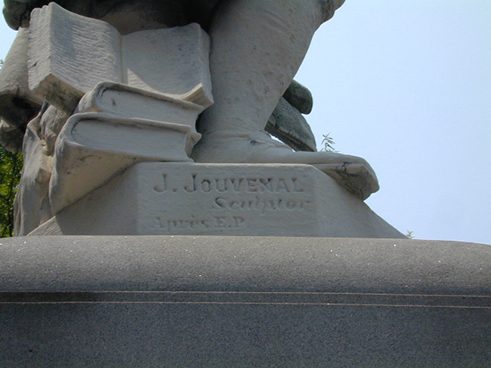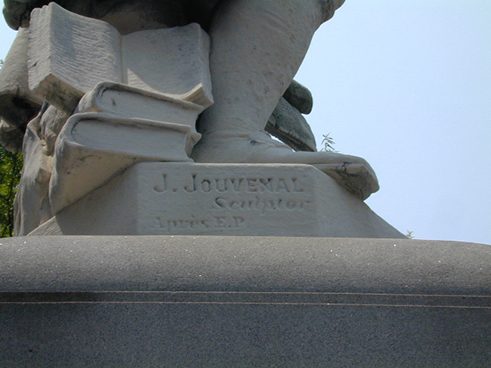Statue of Benjamin Franklin
German Roots in DC
-
Statue of Benjamin Franklin. (2000) -
The base of the statue of Benjamin Franklin contains the name of the German-born sculptor, Jacques Jouvenal. (2000)
The sculpture was a gift of Stilson Hutchins, founder of the Washington Post. An act of Congress (July 19, 1888) authorized the Commissioners of D.C. to designate part of the streets or public places for erection of the statue. The statue was dedicated on Franklin's birthday, January 17, 1889 by Franklin's granddaughter, Mrs. H. W. Emory. The sculpture was originally located at 10th Street and Pennsylvania, across the street from the Washington Post building. It was relocated to its present site in 1982, as part of the Pennsylvania Development Corporation design plan.
Washington's statue of Franklin was designed by a New York-based sculptor-designer, Westphalian-born Ernst Plassman (1823-1877) and sculpted in marble in Washington by Jacques Jouvenal at his studio on D Street NW, between 9th and 10th streets. In 1872, Plassman created a bronze statue of Franklin that stood in Printing House Square, the heart of New York's former newspaper district. Today, the statue is located in lower Manhattan at Park Row and Spruce Street. Although the two statues of Franklin are quite different, Jacques Jouvenal based his work on Plassman's design.
Sculptor Jacques Jouvenal was born in 1829 in Pinache, today part of the town of Wiernsheim, Baden-Württemberg, of a Waldensian Protestant family. Many Waldensians, French pre-Reformation Protestants who were forced to flee their homelands in medieval times, first took up lands in the Italian Piedmont and later settled in Germany (particularly in Württemberg and Baden) and, later in South America, particularly Uruguay and Argentina. In 1699, a group of Waldensians founded Pinache, naming it after Pinasca, the village in Italy that they had left. The village church in Pinache, built in 1721, is the oldest Waldensian church in Germany. (There are also a number of Jouvenals still living in the surrounding towns.) Württemberg's Waldensians continued speaking Occitan, the language of southern France until well into the 19th century. Waldenses also came to the United States, founding communities like Valdese, NC as late as 1893.
Jacques Jouvenal emigrated to the United States in June 1853 and moved from New York to Washington in 1855, where he spent the rest of his life as a sculptor and stonecutter. As the Washington Evening Star noted in its obituary dated March 9, 1905, "Mr. Jouvenal was one of the best known citizens of the Distrct and won fame by his execution of the statue of Benjamin Franklin, [then] near the corner of 10th and Pennsylvania avenue; the bust of Baron Steuben, at the German Orphan Asylum, which was unveiled by President Grant; busts of Jefferson, Van Buren and Webster in the Senate chamber, and other works of note. He was the oldest member of National Lodge, No. 12, of the Masonic order, having been connected with the lodge for forty-nine years."
Jacques Jouvenal's sons, Adolph H. and Rudolph Jouvenal, were also well-known sculptors and stonecutters in Washington. According to the Evening Star, Adolph Jouvenal (born in 1861) was responsible for the erection of the Martin Luther statue (base by Adolf Cluss and Paul Schulze) and Rudolph Jouvenal (born in 1858) carved the capstone and the keystone of the Washington monument.

